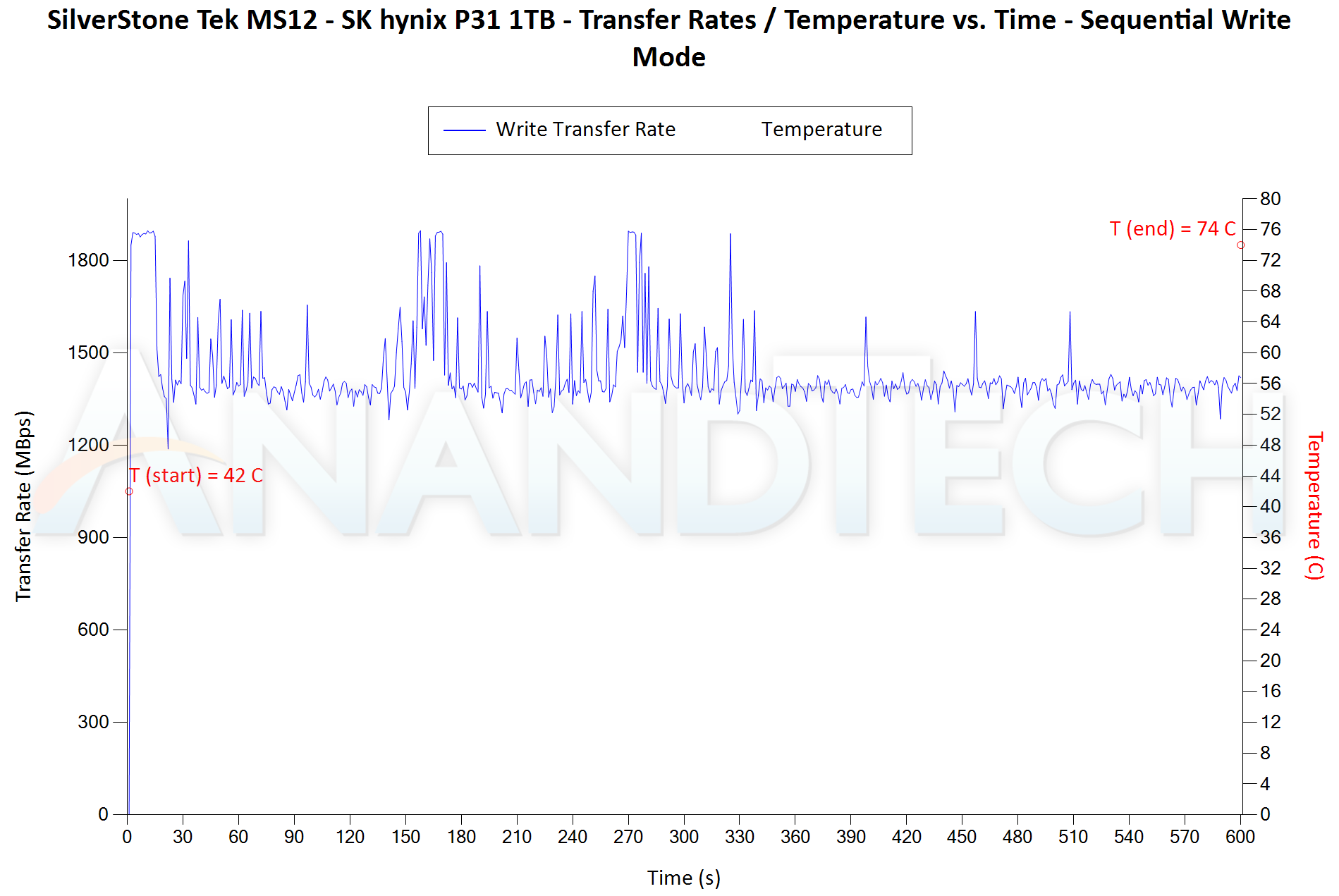Silverstone MS12 and Yottamaster HC2-C3 USB 3.2 Gen 2x2 20Gbps Enclosures Reviewed
by Ganesh T S on August 12, 2021 10:00 AM EST- Posted in
- Storage
- SilverStone
- DAS
- USB 3.2 Gen 2x2
- Portable SSDs
- Yottamaster
Worst-Case Performance Consistency
Flash-based storage devices tend to slow down in unpredictable ways when subject to a large number of small-sized random writes. Many benchmarks use that scheme to pre-condition devices prior to the actual testing in order to get a worst-case representative number. Fortunately, such workloads are uncommon for direct-attached storage devices, where workloads are largely sequential in nature. Use of SLC caching as well as firmware caps to prevent overheating may cause drop in write speeds when a flash-based DAS device is subject to sustained sequential writes.
Our Sequential Writes Performance Consistency Test configures the device as a raw physical disk (after deleting configured volumes). A fio workload is set up to write sequential data to the raw drive with a block size of 128K and iodepth of 32 to cover 90% of the drive capacity. The internal temperature is recorded at either end of the workload, while the instantaneous write data rate and cumulative total write data amount are recorded at 1-second intervals.
| Sequential Writes to 90% Capacity - Performance Consistency | |
| TOP: | BOTTOM: |
 |
|
 |
|
The HC2-C3 comes out on top in the sequential write access test, in contrast to what was observed in the AnandTech DAS Suite workloads. While the MS12 managed to maintain impressive temperatures in that transfer set (going only as high as 65C during the course of the testing, compared to the 70C for the HC2-C3), the situations are reversed in the sustained write testing above. The running out of the SLC cache is only evident for a short duration before the SK hynix Gold P31 recovers and sustains performance numbers around 1750 MBps in the HC2-C3 (down from a peak of 1880 MBps). The temperature was 62C at the end of the 8 minutes it took for the test to complete. On the other hand, when used in the MS12, the Gold P31 tries to get back to peak transfer rates occasionally, but comes out with an average of around 1450 MBps after the running out of the SLC cache. That said, it does manage to maintain the 1880 MBps SLC caching speed for a longer duration compared to the HC2-C3. The temperature also ended up at 74C for the MS12.










21 Comments
View All Comments
meacupla - Thursday, August 12, 2021 - link
Oh, look at that! a newish NVMe to USB bridge chip from ASMediaEven though I know this chip blows the competition out of the water, I would have liked to see how this chip compares to its predecessors, ASM2362, RTL9210 and JMS583.
Was there any stability or drop out issues with these units? I didn't see any mention in the article, so I assume it was smooth sailing, which is nice to see.
Drkrieger01 - Thursday, August 12, 2021 - link
I'd also be curious to know if they experienced any drop outs during testing. I saw this a fair bit with some JMicron controller based units, but I found flashing to another firmware helped tremendously.Nice to see some new hardware available for those still using Sneaker-Mail.
ganeshts - Friday, August 13, 2021 - link
No issues with these two storage bridges attached to the ECU06. I did experience dropouts last year with the Yottamaster C5 [ as documented here : https://www.anandtech.com/show/16133/usb-32-gen-2x... ].name99 - Thursday, August 12, 2021 - link
"USB 2.0 ports are guaranteed to deliver only 4.5W (900mA @ 5V). "No. USB2 ports guarantee 2.5W. It's USB3 ports (blue connector) that guarantee 4.5W.
And lots of USB3 stuff will just fail (possibly randomly) when connected to USB2 because
- 2.5W is enough to get the drive awake and to read, maybe even an occasional write, but not enough for a run of sustained writes.
- I don't think power negotiation is part of baseline USB3 spec. (Or if it is, most of that hardware doesn't seem to implement it properly.)
repoman27 - Sunday, August 15, 2021 - link
Yep. USB 2.0 is up to 2.5 W (500 mA @ 5 V), while USB 3.2 specifies up to 4.5 W (900 mA @ 5 V) for single lane operation and up to 7.5 W (1500 mA @ 5 V) for dual-lane operation.DigitalFreak - Thursday, August 12, 2021 - link
USB 3.2 Gen 2x2, a standard that had little reason to exist.DigitalFreak - Thursday, August 12, 2021 - link
I guess at least it wasn't called USB 3.3 Gen 3.back2future - Monday, August 16, 2021 - link
within time, seen from now, yes, but what to recommend?Waiting for Thunderbolt 4 or building on USB 4.x?
dwillmore - Thursday, August 12, 2021 - link
I read the testbed page--which I usually skip--because I wanted to know where the heck you found a USB3.2 gen 2x2 port. AiC of course.... On the way I learned about the new Type-E connector for internal connection to case USB-C ports. So, that was nice. I even found a USB 3.2 Gen1x2 host adapter--which is a cursed item if ever there was one.watersb - Friday, August 13, 2021 - link
One of my favorite segments to review right now. My laptop purchased in 2021 is by far the most capable device I own. USB4 or whatever they are calling it this week for fast mobile backup storage is a key part of the workflow.Utterly stupefying how clumsy the market messaging has been. The only way to know what I'm are buying is to test it myself. Or get a review from a source that I can trust to go beyond "it looks pretty and we have a relationship with this brand". YouTube reviews have become more sophisticated, but the professionals here help a lot. Thanks!